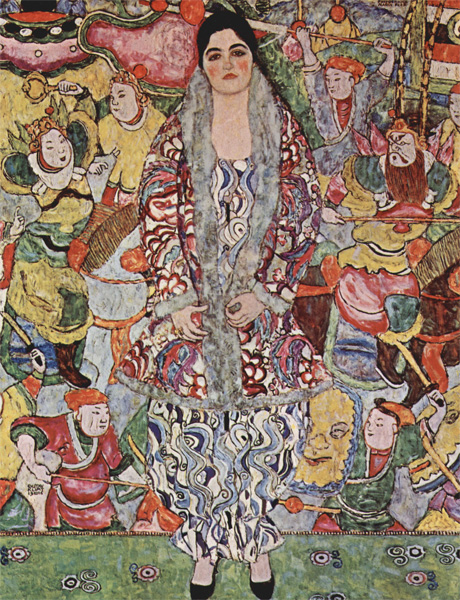Friederike Maria Beer
Gustav Klimt's painting, Friderike Maria Beer (1916), manifests an array of colour highlighting different patterns and forms throughout the piece in an art nouveau style. The muse of the piece was an Austrian high society member, who commissioned Klimt to paint the artwork. The woman posed to the portrait, wearing a hand painted silk dress, paired with a cropped fur coat. The clothing was purchased from the Viennese boutique, Wiener Werkstatte, where the woman as a prominent client.
The painting illustrates Friederike Maria Beer posing as a muse in a beautiful silk dress paired with a fur coat. The silk dress is hand painted from the luxurious boutique, in an eye catching pattern of dark blue, light blue and white swirls carving into one another. The pattern of the dress matches Klimt's classic style of work, bringing into question whether the artist recommended the dress to Friederike based on it's staple colours, or perhaps whether the artist repainted the dress in his own style.
The dress lightly exposes the neck and chest of the model, showcasing the transition of fashion throughout the century. The fur coat is drenched in a luxurious blue trip, slipping into a pattern of colour. Shades of red, white, blues and purples swirl around the coat in small shapes, yet again up rising the question of whether the model was drenched in this incredibly patterned clothing, or if Klimt repainted it in his own style.
The woman's face slightly frowns with orange tinted lips. Her cheeks carry a rosy colour, adding life to her pale face. The prominent Austrian features swipes along her skin, with thick arched eyebrows and black hair hidden behind her head.
The woman holds her coat near its waist, covering her stomach. Her shoes remain a classic black bump, tucked away within are white coloured stockings. The painting is created in depth, depicting a flat green colours floor. Klimt uses a sponge technique and blends the shades of blue with green, paired with small drawings of flowers to continue the patterns throughout the art.
The background of the painting is covered in an array of battles scenes, Klimt used off of a Korean vase he had in his studio. The artist intertwined different visions of oriental art within his work, illustrating classic themes through an array of cultures. A similar painting of Klimt is Baroness Elisabeth Bachofen-Echt, where the artist painted a portrait of an Austrian woman, and paired the background with scenes of Japanese citizens and rulers.
This classic theme runs through the artists work as he feels it depicts a new light and emotion, transforming the portrait to not be solely based on the presence of the model. Klimt blended Western symbols with Oriental imagery, generating a decorative plane that illustrates both form and colour. The classic pieces echo's a modern impressionist method that seizes the attention of viewers through decades.




